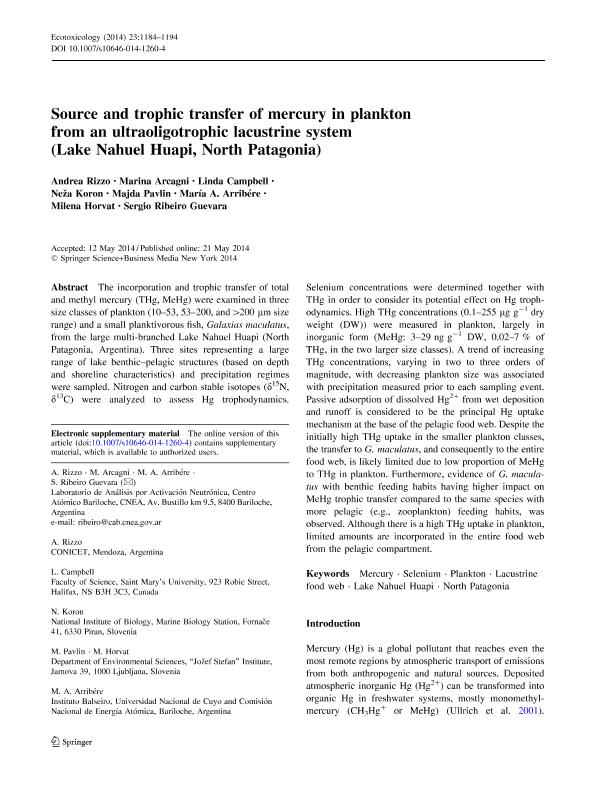Artículo
Source and trophic transfer of mercury in plankton from an ultraoligotrophic lacustrine system (Lake Nahuel Huapi, North Patagonia)
Rizzo, Andrea Paula ; Arcagni, Marina
; Arcagni, Marina ; Campbell, Linda; Koron, Neža; Pavlin, Majda; Arribere, Maria Angelica; Horvat, Milena; Ribeiro, Sergio
; Campbell, Linda; Koron, Neža; Pavlin, Majda; Arribere, Maria Angelica; Horvat, Milena; Ribeiro, Sergio
 ; Arcagni, Marina
; Arcagni, Marina ; Campbell, Linda; Koron, Neža; Pavlin, Majda; Arribere, Maria Angelica; Horvat, Milena; Ribeiro, Sergio
; Campbell, Linda; Koron, Neža; Pavlin, Majda; Arribere, Maria Angelica; Horvat, Milena; Ribeiro, Sergio
Fecha de publicación:
05/2014
Editorial:
Springer
Revista:
Ecotoxicology
ISSN:
0963-9292
e-ISSN:
1573-3017
Idioma:
Inglés
Tipo de recurso:
Artículo publicado
Clasificación temática:
Resumen
The incorporation and trophic transfer of total and methyl mercury (THg, MeHg) were examined in three size classes of plankton (10–53, 53–200, and >200 μm size range) and a small planktivorous fish, Galaxias maculatus, from the large multi-branched Lake Nahuel Huapi (North Patagonia, Argentina). Three sites representing a large range of lake benthic–pelagic structures (based on depth and shoreline characteristics) and precipitation regimes were sampled. Nitrogen and carbon stable isotopes (δ15N, δ13C) were analyzed to assess Hg trophodynamics. Selenium concentrations were determined together with THg in order to consider its potential effect on Hg trophodynamics. High THg concentrations (0.1–255 µg g−1 dry weight (DW)) were measured in plankton, largely in inorganic form (MeHg: 3–29 ng g−1 DW, 0.02–7 % of THg, in the two larger size classes). A trend of increasing THg concentrations, varying in two to three orders of magnitude, with decreasing plankton size was associated with precipitation measured prior to each sampling event. Passive adsorption of dissolved Hg2+ from wet deposition and runoff is considered to be the principal Hg uptake mechanism at the base of the pelagic food web. Despite the initially high THg uptake in the smaller plankton classes, the transfer to G. maculatus, and consequently to the entire food web, is likely limited due to low proportion of MeHg to THg in plankton. Furthermore, evidence of G. maculatus with benthic feeding habits having higher impact on MeHg trophic transfer compared to the same species with more pelagic (e.g., zooplankton) feeding habits, was observed. Although there is a high THg uptake in plankton, limited amounts are incorporated in the entire food web from the pelagic compartment.
Palabras clave:
Mercury
,
Selenium
,
Plankton
,
Lacustrine Food Web
,
Lake Nahuel Huapi
,
North Patagonia
Archivos asociados
Licencia
Identificadores
Colecciones
Articulos(CCT - PATAGONIA NORTE)
Articulos de CTRO.CIENTIFICO TECNOL.CONICET - PATAGONIA NORTE
Articulos de CTRO.CIENTIFICO TECNOL.CONICET - PATAGONIA NORTE
Citación
Ribeiro, Sergio; Horvat, Milena; Pavlin, Majda; Campbell, Linda; Rizzo, Andrea Paula; Koron, Neža; et al.; Source and trophic transfer of mercury in plankton from an ultraoligotrophic lacustrine system (Lake Nahuel Huapi, North Patagonia); Springer; Ecotoxicology; 23; 7; 5-2014; 1184-1194
Compartir
Altmétricas



